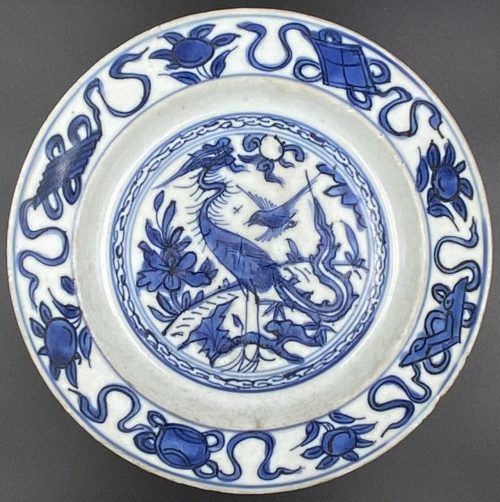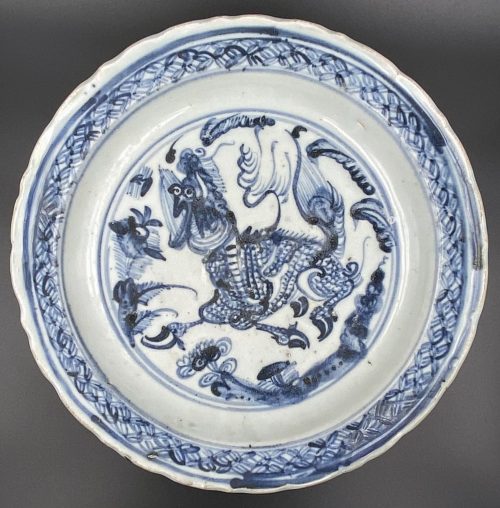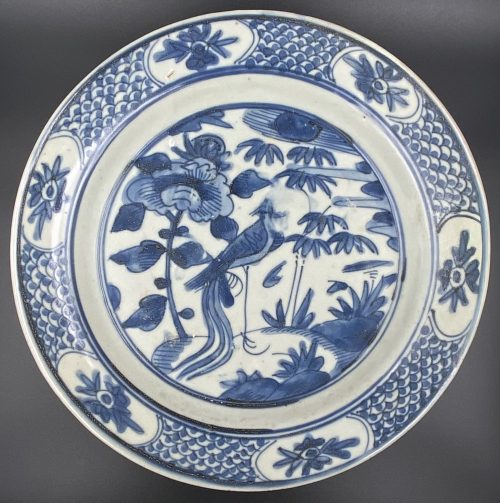Round iron plate of grey colour decorated in low relief (
sukidashi-bori) on the face with sea waves (both layered waves,
seigaiha, and rough waves,
araumi), sago palm (cycas revoluta,
sotetsu), presumably orchid leaves (
ran) - five of them - hanging from the above, and reeds (
ashi), and on the back with waves (
seigaiha only), rocks, chrysanthemums (
kiku), clove (
chori), reed, and presumably orchid leaves - three of them - hanging from the above. The
kozuka-hitsu-ana was probably cut later. The plate is lacking the raised rim, typical for the
kamakura-bori school.
Muromachi period
.
Dimensions: Height: 76.8 mm, width: 76.1 mm, Thickness at
seppa-dai: 3.3 mm, at rim 2.0 mm. Height of
nakago-ana: 29 mm. Weight: 82.4 g.
NBTHK certificate № 402152: Hozon - "Worthy of preservation".
A similar (most probably the same) tsuba is illustrated and described at
Butterfield & Butterfield. IMPORTANT JAPANESE SWORDS, SWORD FITTINGS AND ARMOR. Auction Monday, November 19th, 1979. Sale # 3063 under lot № 66. It describes the piece as following: “
Kamakura bori work of the
Muromachi period. Round thin plate with some small iron bones in the edge. Carved with design of plants (sego palm) rocks, and waves on the face. The back has half of two chrysanthemums, waves, clove, and sego palm leaves. The
kozuka-hitsu has been added and later enlarged. A good typical example without the rim most have. Diameter: 7.7 cm., thickness 2.5 mm. Estimated price $100-200
":

Butterfield & Butterfield, 1979. Sale # 3063, lot № 66.

 English translation of the book indicated above Nihon Tō Kōza, Volume VI, Part 1 by Harry Afu Watson, AFU Research Enterprises, Inc., 1993. Tsuba in question illustrated on page 14 and described as follows: " Tsuba mumei Ōnin. Tetsu ji maru gata ko-sukashi tsuchime shitate shinchū suemon ten zogan maru mimi. Brass suemon". My question remains: why such a text is called 'translation' while it looks more like transliteration of romanization?
English translation of the book indicated above Nihon Tō Kōza, Volume VI, Part 1 by Harry Afu Watson, AFU Research Enterprises, Inc., 1993. Tsuba in question illustrated on page 14 and described as follows: " Tsuba mumei Ōnin. Tetsu ji maru gata ko-sukashi tsuchime shitate shinchū suemon ten zogan maru mimi. Brass suemon". My question remains: why such a text is called 'translation' while it looks more like transliteration of romanization? 




























 Other similar specimens can be found at:
Henri L. Joly and Kumasaku Tomita, Japanese art and handicraft, "Swords and sword fittings" section, sub-section “Inlays of Ōnin, Kyoto, Fushimi-Yoshiro, and Kaga Province”, Plate CX, #128: Iron, chrysanthemoid, thin guard with alternate petals covered with brass spots. Ōnin style. 16th century.
Other similar specimens can be found at:
Henri L. Joly and Kumasaku Tomita, Japanese art and handicraft, "Swords and sword fittings" section, sub-section “Inlays of Ōnin, Kyoto, Fushimi-Yoshiro, and Kaga Province”, Plate CX, #128: Iron, chrysanthemoid, thin guard with alternate petals covered with brass spots. Ōnin style. 16th century.
























